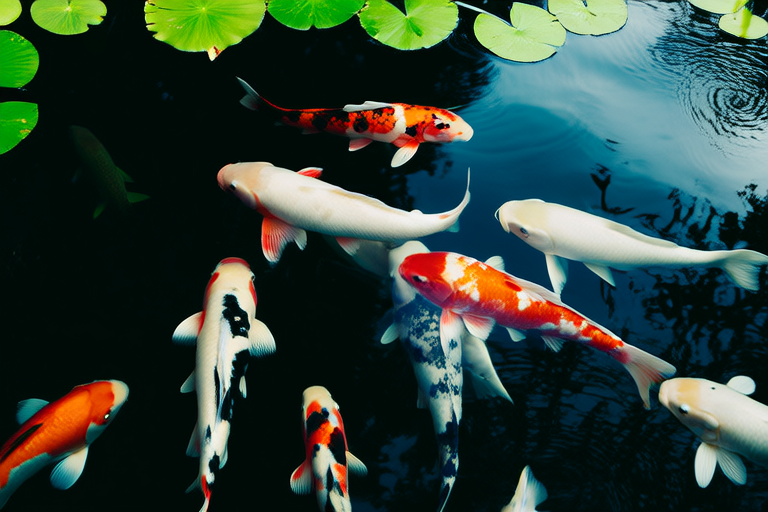The Ultimate Guide to Feeding Your Koi for Optimal Health
Proper nutrition is crucial for the health, longevity, and vibrancy of your koi fish. This comprehensive guide will provide you with all the necessary information to ensure your koi receive the best care through their diet.
Understanding Koi Nutritional Needs
Koi require a balanced diet rich in proteins, fats, carbohydrates, vitamins, and minerals. Proteins are essential for growth, repair, and reproduction, while fats serve as an energy source and help with the absorption of fat-soluble vitamins. Carbohydrates are important for energy, and vitamins and minerals support overall health.
It’s vital to understand that koi have different nutritional requirements depending on their age, size, and environmental conditions. Younger koi need more protein than mature koi because they are still growing. Seasonal changes also affect their dietary needs, with koi requiring higher levels of protein and fat during colder months when they are less active.
Types of Food Suitable for Different Life Stages and Seasons
Life Stages
Young Koi (In Fry Stage): Young koi require specialized diets that are high in protein and easy to digest. These diets typically consist of smaller particles and contain additional nutrients like vitamins and minerals to support rapid growth.
Mature Koi: As koi grow, their dietary needs change. Mature koi benefit from a more varied diet that includes pellets or flakes designed for adult fish. These foods often contain lower protein levels and higher carbohydrate content compared to those formulated for younger koi.
Seasons
Spring: In spring, increase the protein content in your koi’s diet to promote growth after winter dormancy. Use food that is easily digestible to aid recovery from the cold season.
Summer: During summer, koi are highly active and have increased appetites. Provide them with a balanced diet that includes a mix of protein, fats, and carbohydrates to meet their energy demands.
Fall: As temperatures drop in fall, reduce the amount of protein in your koi’s diet but maintain sufficient energy sources to prepare them for winter.
Winter: In winter, when koi become less active, decrease the frequency of feedings and provide food low in protein and high in carbohydrates to sustain them without overloading their digestive systems.
Feeding Schedules
Establishing a consistent feeding schedule is key to ensuring your koi remain healthy. Generally, it’s recommended to feed your koi two to three times daily during warmer months. Reduce the number of feedings to once or twice per day as temperatures drop in autumn and winter.
Always feed at regular intervals to establish a routine. This helps your koi anticipate feeding times and ensures they eat their food before it deteriorates in the pond, which can lead to poor water quality.
Portion Control
Overfeeding can lead to health issues such as obesity, swim bladder disorders, and poor water quality. Conversely, underfeeding can cause malnutrition and stunted growth. To determine the correct portion sizes, observe your koi eating habits.
Feed only what your koi can consume within five minutes. If there is leftover food floating on the surface after this time, reduce the next feeding portion. Adjust the amount based on the number of koi and their size.
Avoiding Overfeeding
Overfeeding is one of the most common mistakes made by koi keepers. It not only leads to health problems for your fish but also poses significant risks to water quality. Uneaten food decomposes in the water, increasing ammonia and nitrite levels, which can be toxic to your koi.
To avoid overfeeding, monitor your koi closely during feeding sessions. If they show signs of satiety, stop feeding immediately. Additionally, ensure that any leftover food is removed from the pond promptly to prevent contamination.
Signs of Proper Nutrition
Healthy koi exhibit vibrant colors, clear eyes, and active behavior. Their fins should be intact and free from damage. Regularly inspect your koi for these signs of good health. If you notice any changes in appearance or behavior, it may indicate a nutritional deficiency or other underlying issue.
Another indicator of proper nutrition is the absence of visible waste in the water. Healthy koi efficiently process their food, producing minimal waste. If you observe excessive waste or discoloration in the water, it could signal overfeeding or poor water quality.
Tips for Maintaining Water Quality After Feeding
After feeding, maintaining optimal water quality is crucial for the well-being of your koi. Here are some tips to help you achieve this:
- Ensure your pond has adequate filtration to remove excess food particles and waste.
- Perform regular water changes to dilute harmful substances produced by uneaten food.
- Monitor pH levels and adjust them if necessary to maintain a stable environment for your koi.
- Use beneficial bacteria supplements to break down organic matter and improve water clarity.
- Install aeration devices to increase oxygen levels in the water, promoting better digestion and overall health.
Conclusion
By following the guidelines outlined in this ultimate guide, you can ensure that your koi receive the optimal nutrition they need throughout their lives. Remember that every pond and every fish is unique, so it’s important to adapt these recommendations to suit the specific needs of your koi. With proper feeding practices and attention to water quality, you’ll enjoy beautiful, healthy koi for years to come.
